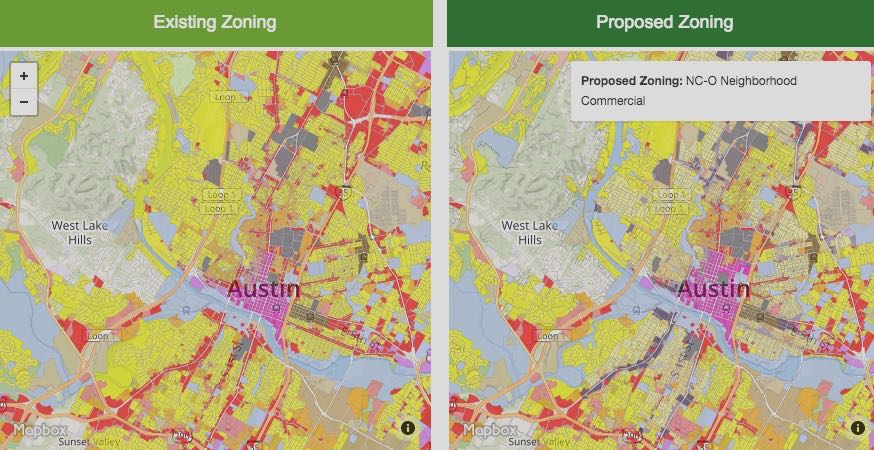The debate and discussion around CodeNEXT heated up this week as community and environmental leaders held press conferences and rallies to share their opinions on the city’s controversial effort to rewrite its land development code.
(As a reminder, CodeNEXT is the city’s effort to rewrite its land development code, which is basically a rule book for the city, explaining what can be built where. CodeNEXT will determine how Austin looks 10, 15, and even 50 years from now. And it will affect everything from affordability, to transportation, to the environment. In other words, it’s a really big deal.)
First on Monday, a group of representatives from Environment Texas, Clean Water Action, and the Texas Public Interest Research Group (TexPIRG) held a press conference calling on Austin leaders to adopt a CodeNEXT, “that promotes the compact and connected development necessary to stop sprawl, reduce car-dependency and protect Austin’s environment as the city continues to grow.”
They called for more housing in the city’s urban core, in order to create the type of density necessary to support public transportation, create walkable neighborhoods, and prevent urban sprawl. Along these lines, they said that the current draft of CodeNEXT is an improvement for the environment over the status quo, but explained that more improvements are still needed, including:
- Shrinking or eliminating parking requirements that encourage single-occupant car trips
- Increasing the amount of housing and jobs allowed along and near major transit corridors
- Encouraging more housing, more housing types (like duplexes and townhouses), and a more efficient use of land throughout the urban core
To support their ideas, the group also unveiled a new report entitled, “Growing Greener: The Environmental Benefits of a Compact and Connected Austin.”
Some key points included in the report are:
- In Austin, a suburban neighborhood with detached single-family homes can consume up to three times more energy in construction and materials, and up to 50 percent more energy in daily operation than a densely developed neighborhood with duplexes and low-rise apartments
- About 35 percent of Austin’s greenhouse gas emissions come from transportation. Studies have shown that people living in compact neighborhoods drive 20 to 40 percent less than those living in sprawling neighborhoods.
- The Texas A&M Institute of Renewable Natural Resources estimates that between 1997 and 2012, Texas lost more than 1.1 million acres of farms, ranches and forests to urban and suburban development, 87 percent of which lie within the state’s 25 fastest-growing counties.
The report also notes some ways to mitigate the localized impacts of denser development. These include:
- Encouraging Green Stormwater Infrastructure projects to compensate for an increase in development in densely developed areas. In a press release from the group, they note that modeling by the Watershed Protection Department has found allowable impervious cover will decrease by 0.57 percent under CodeNEXT, compared to the current code.
- Provide better public transportation to solve for increased vehicular traffic in denser neighborhoods.
- Design streets and buildings that maximize the amount of vegetation and greenery to combat urban heat island effects.
You can read the entire report here>>
At a different press conference held later in the week, Carmen Llanes Pulido (the executive director of Go! Austin/Vamos! Austin) addressed some of these calls for increased density.
“I’m an environmentalist and I don’t disagree with you that compact and connected cities are better for the environment and there’s a big argument to be made that more urban development can be cleaner and greener than sprawl,” Pulido said. “Here’s what’s missing from this conversation. When you densify an urban environment and there is not affordability and you effectively displace families from the central core, where do they go? They sprawl… We’re talking about the suburbanization of poverty.”
This was a common theme throughout the rally hosted Tuesday evening by Community Not Commodity, an organization that has sprung up largely in opposition to the current CodeNEXT draft and process. Many of the speakers (which included P.O.D.E.R’s Susana Almanza, the Save Our Spring Alliance’s Bill Bunch, and the NAACP’s Nelson Linder) spoke about their concerns that Austin’s minority communities are being ignored in the CodeNEXT conversation.
“If we don’t talk about equity,” Pulido said, “you can forget density being a solution for sprawl, you can forget compact cities being an environmental solution…”
Other concerns that Community Not Commodity has raised with CodeNEXT include:
- That it hasn’t been responsive to public feedback
- That it does nothing to resolve Austin’s most challenging problems – housing, income and racial inequality, and neighborhood stability
- That it creates economic incentives to redevelop and tear down Austin neighborhoods
Community Not Commodity is currently supporting a petition effort to create a waiting period before CodeNEXT goes into effect and to put CodeNEXT on the ballot so that voters can ultimately decide whether or not to approve it. You can read through the entire petition here>>
Currently, the plan is for Austin City Council to make a final decision on CodeNEXT in April.





